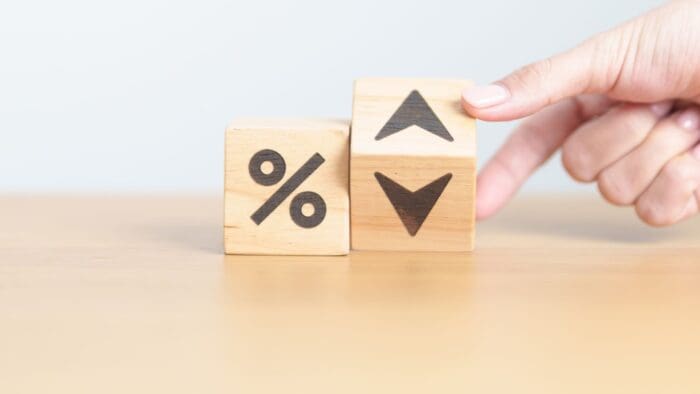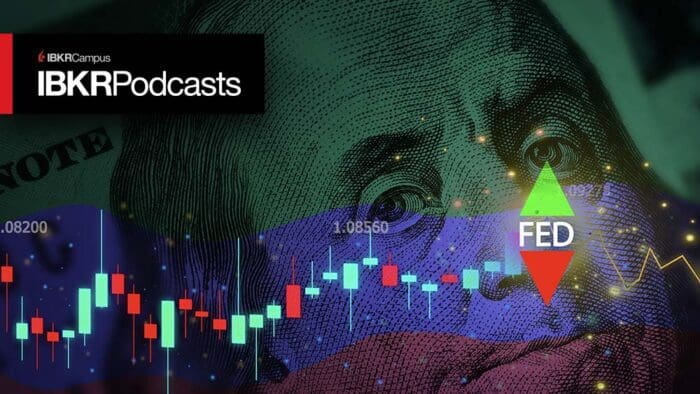Neil Azous at Rareview Capital opines ahead of the November FOMC meeting and concludes that Elvis has left the building, at least when it comes to further policy tightening.
Sponsor Information:
Email: nazous@rareviewcapital.com
Summary – IBKR Podcasts Ep. 113
The following is a summary of a live audio recording and may contain errors in spelling or grammar. Although IBKR has edited for clarity no material changes have been made.
Andrew Wilkinson
Welcome to this week’s podcast. My name’s Andrew Wilkinson. I would normally open this edition of our podcasts by setting the economic landscape for my guest. With the Federal Reserve Open Market Committee in the foreground, usually we’re about to digress over whether the Federal Reserve will or will not add a further notch to short term interest rates. I’m joined today by Rareview Capital’s Chief Investment Officer Neil Azous. Welcome, Neil. How are you?
Neil Azous
Great, Andrew, thank you for having me and great to be here with all of you.
Andrew Wilkinson
You’re very welcome back. I’m just wondering, is this going to be the last time we have Neil Azous on the show? Let me explain a little bit. There’s been a seismic shift in the bond market, Neil, since the the Fed members last met in September, and we’re just heading into the 1st/ 2nd of November meeting. We’re recording this episode the week in advance. It’s not so much about the economy and how the economy has responded materially to higher interest rates is it? What I’m talking about are two events. There’s been a recent speech by Jerome Powell, the Fed chair. And possibly what’s more important are the wild gyrations in the bond market since we last spoke Neil, the yield on the 10-year Treasury note has exceeded 5% during October and as that has happened, the slope of the yield curve has altered radically. So, Neil connect the dots for us and tell us what impact recent events have on the course of monetary policy.
Neil Azous
Sure, Andrew. Well, there are several noteworthy developments regarding the path of interest rates since the last Fed meeting on September 20th. Firstly, the probability for an interest rate hike at the November 1st meeting next week fell to 3% from 21%. So, just as a yardstick or a rule of thumb, the Fed has never really raised an interest rate with the probability of less than 60% going about four weeks into that next meeting. So, as we always like to say, it’s a fait accompli that they’re not going to raise the interest rate. Now, here’s the critical take away from that, Andrew. Well, the last interest rate hike was on the July 26 meeting and as you know, the Fed skipped raising interest rates at the September 20th meeting. So, if the Fed does not hike interest rates next week, it would be the second meeting in a row. Therefore, the sequence and the risk of hiking at every other meeting Andrew leaves the building: That is the technical definition of a cycle ending, and personally I caution people or investors to not romance the idea of quote-unquote maintenance hikes in December or January. The Fed doesn’t operate that way, and there’s no historical precedent for that type of monetary policy randomness. Also, Andrew, since that September 20th FOMC meeting, the probability of an interest rate hike at the December 13th meeting fell from 20/25% down to 20%. So, if you say that differently in odds terms, we fell to a 5-to-1 from a 4-to-1 against a hike by the end of the year. And then finally, on the flip side of the path of policy during the last month, there was also an incremental adjustment in market pricing regarding interest rate cuts. So, the first cut, Andrew, was pulled forward to June from July, and the cumulative probability for the first rate cut between May and July increased about 10% to 144% from 134% or almost 1.5 cuts by June now. So, Andrew, those are the hard facts regarding what the market is pricing currently.
Andrew Wilkinson
When we last spoke in mid-September, Neil, the 10-year yield was around 4.35%. Yet you were modelling, although not necessarily predicting, a potential fifty basis point shift higher in yields. So how significant is the latest surge in yields through 5%?
Neil Azous
Sure, Andrew. The short answer is that the surge higher in long interest rates is material. You referenced the recent speech by chair Jerome Powell. Well, that was the last major Fed speaker before the Fed entered the blackout period ahead of next week’s FOMC meeting. I’m going to just summarize that speech he gave into one phrase, and I apologize: This isn’t directed towards you. This is a generic statement. The quote I would use that summarizes his speech is: “It’s financial conditions, dummy!”. What do I mean by that? If you said that the 10-year nominal interest rate has risen by 100 basis points since the end of July, which it has, and then you transpose that tightening into a financial conditions model that spits out the Fed funds pricing, it equates to about 60 to 70 basis points of Federal Reserve interest rate hikes. So, said differently, Andrew, the long end of the yield curve did the work of the Fed for them. So, it’s material.
Andrew Wilkinson
So that’s equivalent to about three additional quarter point rate increases, right?
Neil Azous
Let’s call it two. Not bad for government’s work!
Andrew Wilkinson
Right. What does history tell us about the end of the tightening cycle and what comes next?
Neil Azous
Well, historically, Andrew, the end of a tightening cycle signals a recession in the intermediate term. Let me just rephrase that or say it again. The intermediate term, if you look at the most generic yield curve slope, which is the 2-year/ 10-year yield curve, it’s not when that curve actually inverts like it did 18-months ago, that a recession follows. It becomes much more of a realistic outcome when it quote- unquote disinverts or goes positive that a recession follows. So, just marking to market what I just said using today’s prices, but thinking about it in an evergreen context, the last price of that generic 2-year/ 10-year yield curve is around -15 basis points. Last week saw the fastest yield curve steepening of this cycle, and now it’s basically a stone’s throw away from going positive for the first time since that first rate hike back in March of 2022. So, now why Andrew, is this relevant or how does it apply to markets? The answer is that the slope of the yield curve significantly impacts macro relationships. Theoretically, a positive slope should see a reversal in the major factors or style premia or sectors. So, for example, growth should underperform value, equal weight should outperform market cap weight, large caps should underperform small caps. And banks and utilities, which have already priced in a good portion of that recession, should begin to outperform the S&P 500 on a relative basis. So, it has a pretty meaningful impact and that’s what history tells us.
Andrew Wilkinson
So, there’s another big potential driver going on right now. What about the the latest events in the Middle East Neil? How do you factor war risk into markets and what steps should somebody take regarding portfolio construction?
Neil Azous
Well, that’s a timely question. So, I mean human emotion as you know, is a dominant factor when making investment decisions and and that’s especially true regarding military conflict including the specter of war now on multiple fronts currently. So, as a steward of capital in our space for what I do, it’s pretty prudent to have a framework in advance if military action materializes. And to further contain emotion, Andrew, it’s also responsible to know the historical facts and the decision-making process that the professional investment community undergoes when they’re faced with the specter of war. So, with that said, the first step in analyzing a geopolitical crisis is really to decide if the event could be systemic, or any external bleeding can be stitched up fast. I mean, stated differently Andrew, we want to know if that event can feed on itself or it could subside quickly and to answer that question, you have to conduct three simple tests. And these are the three tests, and then I’ll tell you how we answer those questions on the test.
The first test is, is a superpower involved and is it operating on their sovereign soil? Why? Because a superpower being involved can project power. That is, they can make their local issue a global one Andrew. Also, if it’s on sovereign soil or there’s risk of war on their own home front, it has the potential to both damage domestic and global economic activity, you know et cetera. So, there’s a big difference per se, say something happening like 9/11 in New York City and the impact on US GDP versus somebody hitting the USS Cole in the Middle East 25 years ago, right, big difference. The second test is you have to ask yourself a question similar to subprime in 2008 during the global financial crisis. Is there a threat to the global banking system if there’s a collapse of a major country’s credit, right? That leads to economic anxiety and various data points will be weaved together into a narrative that there’s going to be a global business slowdown. So, we want to ask that question too. And then the third one, which is the most obvious of the ones you ask yourself; is global crude oil supply involved? Why? Because, as you know, a conflict can cut off shipping lanes, and that has major consequences to the global economy. And historically, Andrew, if the answer to those following three tests is, quote-unquote, no, the default action by the professional investment community is to treat any sell off in risky assets as a buying opportunity.
Well, in this case, the first two tests, as I mentioned; is a superpower involved and is it a threat to the banking system? The answer probably doesn’t apply at this point, meaning there’s no major superpower, there’s no threat to the system. However, the third test certainly does apply; crude oil. And interestingly, in this case it has two potential choke points. Both Russia and the Middle East, right? Cause there’s two activities, two fronts currently. That has never been the case or there’s no playbook for two choke points being in play at once. That’s very interesting and alarming actually. So, armed with that information, Andrew, the argument would be that since the two tests are not in play yet, but the third one being crude oil is, it’s prudent to be mindful of short U.S. Treasury or short U.S. dollar positions and probably at the same time we wouldn’t fault anyone for adding tail risk hedges in crude oil or increasing gold exposure incrementally. But the part about doing a wholesale change to a standard portfolio in advance of a conflict; there’s no basis for that. You just want to do some things around the edges and maybe protect the wings just in case at this stage.
Andrew Wilkinson
Now, Neil, I’ve known you for a long time. I think it’s quite fair to say that you’ve got quite a disdain for gold, probably more so than I do. But why are you so constructive on the price of gold now?
Neil Azous
That’s simple, Andrew. Because the yellow metal’s profile right now has a positive fundamental and technical set including to the point where you could justify increasing the weighting and asset allocation, be it incrementally. And when those factors are aligned, Andrew, it should be acknowledged regardless of our personal opinions or behavior biases. It’s just us being objective. Now, if you followed us for a long time, you know we’ve conducted extensive analysis on gold. We’ve been published over the years in various media outlets regarding our views on gold. And what we’ve just basically come down to when we do all sorts of different analysis is that there are seven fundamental factors that are credited with driving 90% of the gold price. And of those factors, our experience is that gold is the most sensitive to the US real interest rate. The higher the real bond yields go, the lower the gold price should go and vice versa. So, Andrew, if the Fed is indeed ending its tightening cycle, the real interest rate should either be close to a peak or recently have peaked and as they come down from this ultra restrictive level, gold should perform given its historical inverse correlation to that factor.
And then secondly, the technical outlook is probably the most constructive in my career and it pains me to say that out loud, but it is. So, first, just as a reminder, I always like to say that because gold has been around for a long time and have such emotion towards it, it really is the ultimate commodity asset to try to chart. It’s got. It’s got great long-term/ medium-term patterns to look for every discipline you can use matches to it. I don’t care if you’re a Demark guy or you like to big wave surf with Elliot or Elliot wave, etcetera, or us where our discipline is classical technical patterns. And so, I’ll just answer that question on the technical leg using one illustration with classical technical patterns. So, the the dominant classical charting pattern is a 10-year cup and handle pattern using the weekly chart, and so the way that that mechanically works, you know, for people who actually like to understand the definitions of these things, is pretty easy. The target with the cup and handle pattern is the height of the cup and then you just add that to the breakout point of the handle. Well, because this has been going on for 10-years, and if you just use Classical charting basis definitions, that’s really about $1000 higher, or a target of a little over $3000 on the price of gold. Now on a caveat then, I have no idea how long that will take. One-day, one-month, one-year or 25-years. But that’s what the chart is currently saying. For us, it’s easy to be objective when you both have a fundamental factor that drives everything that lines up and the most powerful technical factor that lines up, it’s important to be humble during those periods and this is one of them with gold.
Andrew Wilkinson
As large as your disdain is for gold, I have a similar disdain for politics, particularly US politics, and we’re about a year now away from Election Day. What are the current high level talking points today, either generally or market related?
Neil Azous
Yeah, this is a challenging environment, I’ll give you that. But on the other hand, I kind of actually like talking about politics. Because right now they’re a big driver of things and I think they have the ability when you dumb it down to market context and not personal biases, we’re set up to have a pretty big impact this time round. So, if you just take a starting point to make life easy. The Presidency, the House and the Senate are all up for grabs. The party controlling the house has kept control of the house in 17 straight presidential elections. Then, if you look at the historical precedents and how you could break that well, Democrats are on the offense in the House races, especially given that up until yesterday they did not have a Republican speaker, and so they hold a pretty thin majority in the house, and they’ve got to defend about 18 districts. I won’t get into all the details, but those districts President Biden won back in 2022. So, it’s possible with that historical precedent could break in the House. Just as a yardstick or sort of having a calendar review, just a reminder, you know the primaries start on March 5th and then they go all the way out till mid-September.
There are a couple big unknowns, you know. Will Trump be allowed to run due to the 14th amendment? Will Biden physically be able to run due to his health and age? Will Vice President Harris still be on the ticket or replaced? I only highlight that because Gavin Newsom, has been making the rounds, [he is] the Governor of California. Coincidentally, he was in China yesterday meeting with Xi Jingping in a pretty big ceremony; that is very uncommon. And so, it’s possible they’re grooming him for something. And then if not, you know, is the backup plan a Newsom/ De Santis ticket and that’s what’s coming.
And then I’ll just talk about one last thing because I know we can talk about lots of different subjects, but this is really the overriding theme for me or if I had to dumb it down to the number one talking point at this moment everyone’s talking about, the federal deficit. Right? We all know the deficit horse left the barn. It’s never coming back. It doesn’t matter who’s in the White House, a Democrat or Republican. And they’re both going to spend big indefinitely, and there’s no game plan. There’s no budget negotiation. We’re right back with the new speaker. We might have another continuing resolution or maybe this time in November, the government has to shut down for two to three weeks.
And so, at the end of the day, we’re just going to have a very large annual deficit, and it’s going to continue to increase the overall debt profile. Right? And so, when you think about the two big things that are going to collide in the next 18-months, it’s very simple. We had this powerful Inflation Reduction Act, the IRA, that drives the CapEx cycle and the earnings of companies levered to IRA spending. Well, if Republicans do end up indeed winning and they want to operate either through executive order or because they can get the votes in both bodies of Congress, it’s likely that they will seek to reduce the outlay of that spending act. Well, that’s a form of austerity. Why is that relevant right now? Because right when that’s supposed to supercharge or kick into gear, the Trump tax cuts are expected to expire. There’s no game plan to extend those and also importantly, due to the fiscal situation, there’s no money to expand those. So, the combination of not expanding the Trump tax cuts and the Inflation Reduction Act, seeing some type of incremental reduction in the potential spending that was initially outlined, that combination is not good for the US growth profile potentially heading you know into the period that the Fed’s interest rate hikes are supposed to induce a recession. So, that collective collision is concerning and something to think about in the big picture.
Andrew Wilkinson
Well, at least they could cut interest rates.
Neil Azous
That’s true. We hold that view and that position, Andrew.
Andrew Wilkinson
My guest has been Neil Azous, CIO and founder at Rareview Capital. Thank you very much for joining me Neil.
Neil Azous
Thank you, Andrew. Good luck.
Andrew Wilkinson
Don’t forget folks, you can listen to more podcasts at ibkrpodcasts.com and find us at IBKrcampus.com. And wherever you download your podcasts please do leave us a review. Thanks, Neil.
Neil Azous
Thank you, Andrew.
Disclosure: Interactive Brokers
The analysis in this material is provided for information only and is not and should not be construed as an offer to sell or the solicitation of an offer to buy any security. To the extent that this material discusses general market activity, industry or sector trends or other broad-based economic or political conditions, it should not be construed as research or investment advice. To the extent that it includes references to specific securities, commodities, currencies, or other instruments, those references do not constitute a recommendation by IBKR to buy, sell or hold such investments. This material does not and is not intended to take into account the particular financial conditions, investment objectives or requirements of individual customers. Before acting on this material, you should consider whether it is suitable for your particular circumstances and, as necessary, seek professional advice.
The views and opinions expressed herein are those of the author and do not necessarily reflect the views of Interactive Brokers, its affiliates, or its employees.
Disclosure: Futures Trading
Futures are not suitable for all investors. The amount you may lose may be greater than your initial investment. Before trading futures, please read the CFTC Risk Disclosure. A copy and additional information are available at ibkr.com.















Join The Conversation
For specific platform feedback and suggestions, please submit it directly to our team using these instructions.
If you have an account-specific question or concern, please reach out to Client Services.
We encourage you to look through our FAQs before posting. Your question may already be covered!